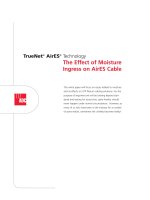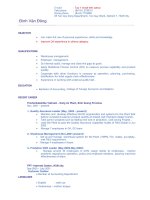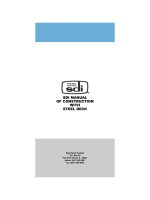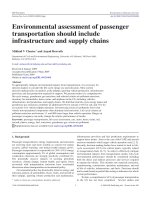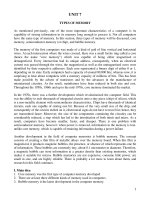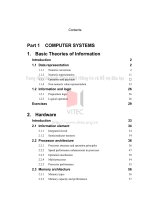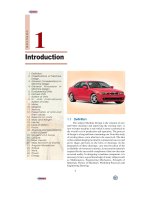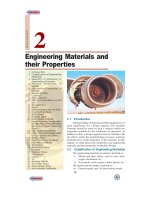Tài liệu Communication Patterns of Engineers doc
Bạn đang xem bản rút gọn của tài liệu. Xem và tải ngay bản đầy đủ của tài liệu tại đây (2.87 MB, 278 trang )
COMMUNICATION
PATTERNS
OF ENGINEERS
ffirs.qxd 3/31/2004 7:16 AM Page i
IEEE Press
445 Hoes Lane
Piscataway, NJ 08854
IEEE Press Editorial Board
Stamatios V. Kartalopoulos, Editor in Chief
M. Akay R. J. Herrick M. S. Newman
R. J. Baker R. F. Hoyt M. Padgett
J. E. Brewer D. Kirk W. D. Reeve
M. E. El-Hawary R. Leonardi S. Tewksbury
G. Zobrist
Kenneth Moore, Director of Business and Information Services
Catherine Faduska, Senior Acquisitions Editor
Christina Kuhnen, Associate Acquisitions Editor
IEEE Education Society, Sponsor
EDS Liaison to the IEEE Press, Robert J. Herrick
IEEE Professional Communications Society, Sponsor
PCS Liaison to the IEEE Press, Gene Hoffnagle
Technical Reviewers
Thomas E. Pinelli, NASA Langley Research Center
W. David Penniman, University of Buffalo
Katherine Thomes, University of Pittsburgh
ffirs.qxd 3/31/2004 7:16 AM Page ii
COMMUNICATION
PATTERNS
OF ENGINEERS
CAROL TENOPIR
DONALD W. KING
IEEE Education Society, Sponsor
IEEE Professional Communications Society, Sponsor
A JOHN WILEY & SONS, INC., PUBLICATION
IEEE PRESS
ffirs.qxd 3/31/2004 7:16 AM Page iii
Copyright © 2004 by the Institute of Electrical and Electronics Engineers, Inc. All rights reserved.
Published simultaneously in Canada.
No part of this publication may be reproduced, stored in a retrieval system or transmitted in any form or
by any means, electronic, mechanical, photocopying, recording, scanning or otherwise, except as
permitted under Section 107 or 108 of the 1976 United States Copyright Act, without either the prior
written permission of the Publisher, or authorization through payment of the appropriate per-copy fee to
the Copyright Clearance Center, Inc., 222 Rosewood Drive, Danvers, MA 01923, (978) 750-8400, fax
(978) 646-8600, or on the web at www.copyright.com. Requests to the Publisher for permission should
be addressed to the Permissions Department, John Wiley & Sons, Inc., 111 River Street, Hoboken, NJ
07030, (201) 748-6011, fax (201) 748-6008.
Limit of Liability/Disclaimer of Warranty: While the publisher and author have used their best efforts in
preparing this book, they make no representation or warranties with respect to the accuracy or
completeness of the contents of this book and specifically disclaim any implied warranties of
merchantability or fitness for a particular purpose. No warranty may be created or extended by sales
representatives or written sales materials. The advice and strategies contained herein may not be
suitable for your situation. You should consult with a professional where appropriate. Neither the
publisher nor author shall be liable for any loss of profit or any other commercial damages, including
but not limited to special, incidental, consequential, or other damages.
For general information on our other products and services please contact our Customer Care
Department within the U.S. at 877-762-2974, outside the U.S. at 317-572-3993 or fax 317-572-4002.
Wiley also publishes its books in a variety of electronic formats. Some content that appears in print,
however, may not be available in electronic format.
Library of Congress Cataloging-in-Publication Data:
Tenopir, Carol.
Communication patterns of engineers / Carol Tenopir, Donald W. King.
p. cm.
Includes bibliographical references and index.
ISBN 0-471-48492-X (cloth : alk. paper)
1. Communication in engineering. I. King, Donald Ward, 1932– II. Title.
TA158.5.T46 2004
620'.001'4—dc22 2003062037
Printed in the United States of America.
10987654321
ffirs.qxd 3/31/2004 7:16 AM Page iv
CONTENTS
Preface ix
1 Introduction 1
1.1 Focus of the Book 1
1.2 Structure of the Book 6
2 Communication Models 11
2.1 Introduction 11
2.2 Models of Communication Systems 12
2.3 Models of Scholarly Journals 14
2.4 Models of Information Seeking 22
3 A Communications Framework for Engineers 27
3.1 Introduction 27
3.2 Time Engineers Spend Communicating 29
3.3 Engineers’ Communication Channels 31
3.4 Factors Affecting Engineers’ Communication 35
Choices
v
ftoc.qxd 3/31/2004 7:18 AM Page v
4 The Engineering Profession and Communication 37
4.1 The Engineering Profession 37
4.2 How Industry and Government Engineers Spend 38
Their Time
4.3 The Importance of Information Resources to 38
Engineers’ Work
4.4 The Value of Reading 41
4.5 The Impact of Information on Innovation 44
4.6 Organizing Information for Better Use in 46
the Workplace
4.7 Engineers’ Adaptation to Information Innovations 52
5 Engineers’ Information Seeking and Use 57
5.1 Introduction 57
5.2 Engineers’ Channels for Information Seeking 58
and Use
5.3 Resources Used by Engineers for Information 63
Seeking
6 Factors Affecting Information Seeking and Use 71
6.1 Introduction 71
6.2 Effects of Geographic and Cultural Differences 72
on Information Seeking and Use
6.3 Effects of the Nature of Work on Information 74
Seeking and Use
6.4 Effects of Organization Policies on Information 83
Seeking and Use
6.5 Effects of Personal Characteristics on Information 85
Seeking and Use
7 Information Output by Engineers 89
7.1 Introduction 89
7.2 Channels Engineers Use to Communicate 91
Information Output
7.3 Resources and Tools Engineers Use for 94
Communicating Information Output
7.4 Communicating the Written Word 95
8 Engineering Education and Communication Skills 99
8.1 Introduction 99
vi
CONTENTS
ftoc.qxd 3/31/2004 7:18 AM Page vi
8.2 Improving Engineers’ Communication Skills 100
8.3 Improving the Use of Communication Channels 108
and Sources
9 The Engineering Scholarly Journal Channel 113
9.1 Introduction 113
9.2 Engineering and Science Journal 114
Characteristics: 1977, 1995, and 2001
9.3 Engineers’ and Scientists’ Authorship and 117
Reading of Scholarly Journals
9.4 Changes in Information-Seeking and Reading 126
Patterns Following Electronic Journals
10 Engineers’ Journal Information-Seeking and 133
Reading Patterns in an Emerging Electronic Era
10.1 Introduction 133
10.2 Use, Usefulness, and Value of Articles to 135
Engineers
10.3 Where Engineers Get the Articles They Read 139
10.4 Format of Articles Read 140
10.5 How Engineers Learn About the Articles 141
They Read
10.6 Age of Articles Read 143
10.7 Factors That Affect Use 144
11 Engineering Communication Patterns Compared 149
with Science and Medicine
11.1 Introduction 149
11.2 Professions of Engineering, Science, and 151
Medicine
11.3 Communication Channels Used by Engineers, 155
Scientists, and Medical Professionals
11.4 Resources and Tools Used by Engineers, 158
Scientists, and MedicalProfessionals
12 The NASA/DOD Aerospace Knowledge Diffusion 163
Research Project
12.1 Introduction 163
12.2 Focus on Commercial Aircraft Manufacturing in 164
the United States
CONTENTS
vii
ftoc.qxd 3/31/2004 7:18 AM Page vii
12.3 Communication by U.S. Aerospace Engineers 166
and Scientists
12.4 Other Related Work 175
12.5 Summary 179
13 Summary 181
Bibliography 187
Index 253
About the Authors 265
viii
CONTENTS
ftoc.qxd 3/31/2004 7:18 AM Page viii
PREFACE
In the fall of 2000 the Engineering Information Foundation (EIF)
Board of Directors asked Donald W. King to advise them on possi-
ble future research directions. In a presentation to the Board, Mr.
King recommended a four-phase approach to a research agenda
regarding the communication of engineers, starting with a review
of recent literature to identify where benchmark data exist, where
there are gaps in research, and where future research would be
beneficial to the engineering communities. As a result of this rec-
ommendation, the Board awarded a research grant to Carol
Tenopir and Donald W. King to conduct a literature review and to
present recommendations for future research directions. The re-
port to EIF was the genesis of this book. The report focused on the
literature from 1994 to the present pertaining to how engineers
communicate. This book expands that focus to include literature
from the 1960s to the present. The emphasis, however, remains
on how engineers communicate, whether communication patterns
have changed, and what might be done to improve communication
of engineers.
This book broadly defines communication as encompassing in-
formation inputs such as seeking, locating, obtaining, and using
information on the one hand and information outputs such as
ix
fpref.qxd 3/31/2004 7:20 AM Page ix
writing and oral communications. A particular emphasis is on
how communication can be improved through education. We ana-
lyzed the literature that touches on these topics, particularly the
research literature with engineers as the subject, either wholly or
in part. We also extracted survey responses from engineers who
were observed nearly every year from 1977 to 2003. These data
provided useful insights into engineers’ communication patterns
and useful comparisons with science and other fields.
This project has been a group effort (not unlike the trend in engi-
neering toward collaborative works). Project leaders Carol
Tenopir and Donald King were ably assisted in all aspects by
Rhyn Davies, Christine L. Ferguson, Edward Gray, and Scott
Rice, graduate students at the University of Tennessee, School of
Information Sciences. In addition, graduate students Katie Dar-
raj, Keri-Lynn Paulson, Emily Urban, and Mercy Ebuen assisted
with occasional specific tasks. At the University of Pittsburgh,
School of Information Sciences, Sarah Aerni, Richard Daddieco,
Matt Herbison, and Gina Cecchetti also made helpful contribu-
tions.
Without the initial funding and encouragement by the Engineer-
ing Information Foundation, this project would not have been
possible. We would like to extend special thanks to the EIF
Board, including; Melvin Day; Thomas R. Buckman, President;
Anne M. Buck, Vice-President; Hans Rütimann, Secretary; John
J. Regazzi, Director; Julie A. Shimar, Director; and Ruth A.
Miller, Executive Associate. Their comments, corrections, and en-
couragement were essential to this book. The authors also wish
to partially dedicate this book to the memory of Anne M. Buck, a
dedicated and caring engineering librarian.
C
AROL
T
ENOPIR
D
ONALD
W. K
ING
Knoxville, Tennessee
Pittsburgh, Pennsylvania
August 2003
x
PREFACE
fpref.qxd 3/31/2004 7:20 AM Page x
Communication Patterns of Engineers. By Carol Tenopir and Donald W. King
1
ISBN 0-471-48492-X © 2004 Institute of Electrical and Electronics Engineers
1.1 FOCUS OF THE BOOK
This book is a review and analysis of the literature and presenta-
tion of data from a series of surveys that attempts to provide in-
sights into how engineers communicate. Much of the focus of the
book is on the professional aspects of engineers’ work, the infor-
mation resources used to perform their work, and information
output from their work that is communicated to others. Many of
our studies and those of others dealt with traditional interperson-
al and written communication channels. Together, these studies
provide abundant evidence of the many factors that motivate en-
gineers to use various communication channels. However, it
seems clear that new technologies, such as the World Wide Web
and electronic publishing, are having a profound effect on engi-
neering communication patterns. We believe that knowledge and
understanding of engineers’ motives, incentives, and reasons for
communicating in the past will help frame future communication
practices.
During the late 1980s and early 1990s, the Internet, and
specifically the World Wide Web, became popular, making elec-
tronic and digitally based products (i.e., electronic journals) not
only possible, but economically practical. By the late 1990s, elec-
tronic products became widely available and accepted by authors
1
INTRODUCTION
c01.qxd 11/19/2003 9:54 AM Page 1
and readers. The Internet has dramatically increased the poten-
tial for both informal and formal communication. People have
the option of easy and immediate contact with friends and col-
leagues all over the world, there has been an evolution of inten-
sive groups of engineers on the Internet with interests in mate-
rials, nanotech, electronics, and so on. They can choose which
format of many best suits their communication and information
needs and requirements. Libraries also now have the option of
choosing between print or electronic formats. Libraries and in-
formation centers exist to provide information services to their
users, so it is important to find out which formats users prefer
and how potential benefits offered by electronic resources will fa-
cilitate the research and development process and help (or hin-
der) engineers to do their work. Consequently, interest has in-
creased regarding studies of and publications on scholarly
communication and information exchange processes and systems
since 1994. Many of these are directly applicable to engineers.
This book synthesizes the historical context surrounding early
studies on the communication practices of engineers and scien-
tists; looks at various aspects of communication through scientific
and technical information (STI); examines the literature that dis-
tinguishes the information needs and uses of engineers from
those of scientists; and offers a review of significant studies and
projects that explore the communication practices of engineers.
The 1950s witnessed several excellent studies of how engineers
and scientists communicate; however, research and surveys on
the relationship between scientific activity and STI research took
off in the 1960s, largely due to funding from the U.S. federal gov-
ernment and governments in Europe. The 1970s and 1980s saw a
continuation of these studies, although this research slowed down
by the early 1990s. Most of these studies defined communication
broadly to include the creation of knowledge and its preparation
for dissemination, the numerous channels by which it could be
transmitted, and the assimilation and use of information the en-
gineers received. Various meanings to the terms “information
needs,” “information seeking,” and “information use” are found in
the literature. For example, to some communication researchers
“information needs” refer to the sources of information used,
while for other researchers, “information needs” apply to the in-
formation content needed by engineers. Still others define “infor-
mation needs” as the reasons for needing information.
2
INTRODUCTION
c01.qxd 11/19/2003 9:54 AM Page 2
Five types of models were used to examine STI communication
in communication research since 1970. These models either:
1. Focus on communication during research and development
projects and tasks; or
2. Follow the flow of information between individual engineers;
or
3. Track information through its life-cycle; or
4. Examine the amount of information activity and use in-
volved in specific work activities or by specific participants;
or
5. Measure the amount and characteristics of information flow
between various functions and participants.
It has been well documented over several decades that engineers
spend much of their time communicating. This is often done to en-
hance their professional performance, as there is ample evidence
of a correlation between engineers’ communication and their work
performance. However, the importance given to different types of
information (e.g., literature versus interpersonal exchange) being
communicated varies among studies. Furthermore, choices from
among information sources are often dictated by factors, such as
ease of use or cost considerations.
Many studies found that personal and interpersonal informa-
tion sources are used initially by engineers and that internally
published technical reports are favored over externally published
documents. For this reason, uses of journal articles, books, and
other sources of externally published material were given less em-
phasis by communication researchers. Later research began to fo-
cus on the importance of journal articles and discovered that engi-
neers in universities read scholarly articles a great deal and
engineers elsewhere read them less frequently, but value them
nevertheless. Research and engineering education also began to
focus on the importance of writing, presentation, and other com-
munication skills.
The research on secondary sources of STI during this period
was as extensive as that on primary sources. Most of the studies
on secondary sources focused on automated bibliographic search-
ing, with little attention on printed indexes or numeric databases.
Studies from the 1960s dealt with the quality of output from in-
1.1 FOCUS OF THE BOOK
3
c01.qxd 11/19/2003 9:54 AM Page 3
formation retrieval systems. Studies in the 1970s and 1980s of
automated bibliographic databases tended to address evaluation
or research involving system innovation and on “end-user”
searching. Library resources and librarians were shown in the lit-
erature to be “under-used” by engineers in the completion of ma-
jor projects. Libraries often fill a niche in the communication
process, however, by providing for special needs, such as identify-
ing and providing access to older or costly material.
There were many extensive reviews of engineering communica-
tion and related literature throughout this period. These include
chapters in the Annual Review of Information Science and Tech-
nology (Menzel, 1966b; Herner and Herner; Paisley, 1968; Allen,
1967, 1969; Lipetz, 1970; Crane, 1971a; Lin and Garvey, 1972;
Martyn, 1974; Crawford, 1978; Dervin and Nilan, 1986; Hewins,
1990; King and Tenopir, 2000); several books (Pinelli, Barclay,
Kennedy, and Bishop, 1997a,b; Griffith, 1980; Kent, 1989; Nelson
and Pollock, 1970; Mikhailov, Chernyi, and Giliarevskii, 1984;
Williams and Gibson, 1990; Hills, 1980; Katz, 1988; Tenopir and
King, 2000a), reports such as those produced by Pinelli and col-
leagues and King with Casto and Jones; and PhD dissertations
such as Raitt.
Studies concerning STI communication often do not make the
distinction between scientists and engineers. Authors who dis-
cussed the variations between the two groups before 1994 include
Gould and Pearce (1991), Blade, Rosenbloom, and Wolek (1967),
Allen (1988), and Pinelli (1991). Engineers were found to rely
more on informal and interpersonal information sources than of
published literature (Rosenbloom and Wolek 1967; Allen 1988)
and they also read fewer journal articles and use the library less
than scientists (Griffiths, et al.).
Several sustained and exemplary STI communication research
projects were performed from the 1960s through the current time.
All of these studies have relied heavily upon data collected from
statistical surveys of engineers. The first of these studies, by
William Garvey and colleagues at The Johns Hopkins University,
began in the early 1960s and lasted until the 1970s. Their work
had two major foci. First, they were interested in the “flow” of STI
through various communication channels such as internal re-
ports, professional meetings, journal articles, and so on. They de-
veloped a timeline to show when created information would ap-
pear in each of these channels. Second, they examined which
4
INTRODUCTION
c01.qxd 11/19/2003 9:54 AM Page 4
sources of information engineers used for completing their work
activities.
Thomas Allen and his colleagues at the Massachusetts Insti-
tute of Technology performed another series of studies initiated in
the mid-1960s which continued into the early 1990s. Their work
involved “record analysis” and self-administered questionnaires
of engineers, which revealed that there are often individuals in an
organization known as “stars” or “gatekeepers” upon whom others
heavily rely on as sources for internal and external information.
They identified nine basic information channels and determined
the extent to which each of these channels are used, the value of
these channels, and the factors which lead to their use.
King Research performed statistical descriptions of STI from the
1970s to the 1990s. Under National Science Foundation (NSF) con-
tracts, King Research performed a series of studies to develop sta-
tistical indicators of STI. This research provided trends and pro-
jections for STI literature, libraries, authorship and information
use by scientists and engineers, and STI expenditures in the
United States. One finding debunked the myth of an “information
explosion.” Rather, growth in the literature merely reflected a
growth in the number of scientists and engineers, a fact that holds
true today. In 1976, they began research on the feasibility of elec-
tronic publishing of journal articles and concluded that the short-
term future would have a two-tier system of dissemination (print
and electronic). Results from the journal studies led to a book
(King, McDonald, and Roderer, 1981) in which the entire journal
system is described in detail. They then started research in 1981 to
explore the use, usefulness, and value of STI and the contribution
that STI services make to these outcomes. From the 1980s to the
late 1990s, King Research performed numerous proprietary stud-
ies in various organizations to determine the communication activ-
ities of professionals (including scientists and engineers). Their
work found that engineers and scientists spend a majority of their
time communicating. They also found that engineers and scientists
use a variety of information sources with choices being dictated by
economics among other factors (new analyses from these studies
and more recent comparative data are included in several chapters
in this book). A continuation of these studies is being continued at
the University of Tennessee (Tenopir under SLA, EIF, and other
sponsorship), Drexel University, and University of Pittsburgh.
From 1977 to 1981, Hedvah Shuchman and colleagues of The
1.1 FOCUS OF THE BOOK
5
c01.qxd 11/19/2003 9:54 AM Page 5
Futures Group conducted surveys of engineers employed at 89
firms. Sponsored by the NSF, these surveys examined the steps
used in locating information needed to solve a project or task. The
most important steps were personal stores of technical informa-
tion, informal discussions with colleagues, and discussions with
supervisors. They also found a discrepancy between the sources of
information used and sources of information produced.
Beginning in the early 1980s and continuing into the 1990s,
Thomas Pinelli, John Kennedy, Rebecca Barclay and their col-
leagues examined the diffusion of knowledge through the aero-
space industry. Their work was undertaken as the NASA/DOD
Aerospace Knowledge Diffusion Research Project and was done in
collaboration with the NASA Langley Research Center, the Indi-
ana University Center for Survey Research, and Rensselaer Poly-
technic Institute. The project tracked the flow of STI at the indi-
vidual, organizational, national, and international levels and
examined the communication channels in which STI flows and
the social system of knowledge diffusion. More information on the
NASA/DOD Aerospace Knowledge Diffusion Research Project can
be found in Chapter 12, which is dedicated entirely to this exten-
sive research.
The data for this book are derived from many sources. A prima-
ry source is from readership surveys performed by King Research
and the University of Tennessee School of Information Sciences,
totaling results from over 15,000 scientists. Conducted since
1974, these surveys looked primarily at journal readership, al-
though use of library and other information services was also con-
sidered. Data also came from the tracking of 715 scientific jour-
nals over a 40-year period and numerous cost studies of scientists’
activities, library services, publishing, and other processes rele-
vant to the journal system.
1.2 STRUCTURE OF THE BOOK
In Chapter 2, we describe a few of the many models that depict
engineering communication. The principal models presented here
attempt to illustrate the complexity of communication processes,
which consist of many interpersonal or oral channels (e.g., infor-
mal and formal discussions, presentations, lectures, etc.) and
written or recorded channels (e.g., letters and e-mail, electronic
6
INTRODUCTION
c01.qxd 11/19/2003 9:54 AM Page 6
engineering handbooks and manuals, documentation of work,
conference proceedings, articles, books, patents, etc.). Multiple
channels exist because each serves specific information needs and
requirements. Some information passes through a multitude of
channels over time and a model is presented describing the “life”
of information through these channels. Some channels, such as
those found in the literature, involve many important system-like
functions and the participants who perform these functions.
These relationships and the life cycle of information through the
journal channel form the basis for other communication models
that are changing with new technologies.
Chapter 3 discusses the interrelationships among the engineer-
ing professions and work performed, resources used to perform
engineering activities, and the output from those work activities.
Information, of course, is an essential input resource to the work
process, as well as a tangible output from the work process. We
emphasize that receiving and using information requires substan-
tial amounts of engineers’ time, as well as, the use of information
seeking tools such as technologies and library resources. The
same is true in information outputs such as in preparing presen-
tations and documents.
Chapter 4 deals with the engineering profession and how engi-
neers go about their work. Examples are given for the amount of
time engineers (in industry and government) spend in various
work activities and the relative importance of information re-
sources used by engineers to perform these activities. We also dis-
cuss engineers’ general communication practices and how well
they adapt to communication innovations. The fourth chapter also
investigates how engineers assimilate new information into the
work process, how they revise their work to take advantage of it
and what the outcomes are of using the information. New infor-
mation may also render old information obsolete, or indicate new,
previously unimagined possibilities for the use of old information.
We also examine how new technology might improve how engi-
neers communicate in the workplace.
In Chapter 5, we first examine information seeking and use by
engineers. There are three stages to this process: information
seeking, information receiving, and reading/listening. Engineers,
having decided that they have a need for information, must at-
tempt to find information that best suits their need. Both of
these processes form information seeking. When they have iden-
1.2 STRUCTURE OF THE BOOK
7
c01.qxd 11/19/2003 9:54 AM Page 7
tified some information, in the form of an article or conference
proceeding, for example, they must then attempt to acquire the
information. There are many possible avenues through which
users can acquire information: from asking a colleague, using a
library resource, to logging a formal request for document deliv-
ery with a reprint service. The third stage, reading/listening, is
the incorporation or assimilation stage. There are many levels of
incorporation. Sometimes people skim through an article, only
reading the principal statements and glancing at the figures;
other times people, read very thoroughly; and most times people
do a combination of the two at different times. Some of our re-
search and data reveal evidence about the way engineers read
relative to scientists in other fields. There has been less research
on listening by engineers; however, since so much of the commu-
nication by engineers is oral, studies of listening and under-
standing are of particular relevance to the education and re-
search communities. In this chapter, we also describe the extent
to which channels are used and how much time is spent in in-
formation seeking and use. Chapter 6 pays particular attention
to factors that affect engineers’ communication channels, such as
geographic or cultural differences among engineers; differences
among branches of engineering; nature of the work performed;
organizational policies; and personal characteristics such as gen-
der, age, and so on.
Chapter 7 explores the facets of output and communicating in-
formation. The two major aspects in this chapter are writing and
presentations. This is the communication stage, wherein engi-
neers disseminate the results of their research or engineering out-
put to their colleagues or to the public. We explore trends in how
engineers communicate information in writing, verbally, in con-
ferences or presentations, or in formal education settings, such as
classrooms. We provide estimates of the amount of communica-
tion (e.g., presentations made, proposals written, etc.) and the
time spent communicating. Chapter 8 discusses how education
and training are changing in order to improve communication
skills of engineers.
Because of the importance of engineering journals and the
changes due to electronic publishing, Chapter 9 is devoted to the
engineering journal channel. In this chapter, we examine the
trends in authorship, reading, information seeking patterns, and
publishing of engineering scholarly journals. We also present spe-
8
INTRODUCTION
c01.qxd 11/19/2003 9:54 AM Page 8
cific readership data: How articles are identified and where they
are obtained. In particular, we present survey results for engi-
neers’ reading patterns before and after electronic journals be-
came available.
Since electronic publishing is making a profound impact on in-
formation seeking and reading patterns, we devote all of Chapter
10 to survey evidence of these changes. This chapter examines
current (2000 to 2003) observations of the use, usefulness, and
value of journals; where engineers now obtain their articles; how
they learn about the articles they read; the format read (print or
electronic); issues concerning the age of articles read; and factors
that affect choices from among journals read, sources used, and
means of identifying articles.
Chapter 11 examines differences in engineers’ communication
patterns and also differentiates between engineers and scientists
and medical professionals. Knowing precisely how expectations
and communication styles differ between cultures can inform and
potentially improve collaboration between engineers in different
regions. It is equally useful to examine how information use pat-
terns vary depending on the gender, age, level of education, or ex-
perience of engineers. Work roles assumed by the same individual
over time and specialization in different fields of engineering also
affect how engineers use information, because the types of goals
and the procedures required to meet them differ substantially
with different work roles or branches of engineering. Even
stronger differences exist between engineering as very practical
and applied, and science, which can be more theoretical and ex-
perimental. Chapter 12 elaborates on the extensive work per-
formed by Pinelli and colleagues, which was discussed earlier.
Finally, Chapter 13 summarizes the findings and provides conclu-
sions about the communication patterns of engineers.
1.2 STRUCTURE OF THE BOOK
9
c01.qxd 11/19/2003 9:54 AM Page 9
c01.qxd 11/19/2003 9:54 AM Page 10
Communication Patterns of Engineers. By Carol Tenopir and Donald W. King
11
ISBN 0-471-48492-X © 2004 Institute of Electrical and Electronics Engineers
2.1 INTRODUCTION
Innovation never happens in a vacuum; innovation requires com-
munication. Just as work on the cutting edge of engineering and
science has become more technical and complex, so too has the
process of communicating. In becoming so, communication has
unfortunately also become more complex and cumbersome for
many of the engineers. Engineering is increasingly collaborative,
multidisciplinary, and global, but the goals of engineering pro-
jects are becoming progressively more refined and specialized.
Generally, the more narrow the discipline and the more special-
ized the information needs of its practitioners, the more difficult
it is to find good information easily. Engineers are rarely taught
advanced techniques of information retrieval, however, and are
typically not naturally gifted communicators, making it difficult
to fill their complex information needs (which can then impair
their ability to produce high-quality work).
In the quest to make all stages of research, development, de-
sign, and production as efficient and effective as possible, it is
important to posses a clear understanding of how engineers de-
termine their information needs, fill them, use the information,
and share their own resulting information. By discovering these
patterns and systematizing that knowledge, communication can
2
COMMUNICATION MODELS
c02.qxd 11/19/2003 9:53 AM Page 11
be improved and communication at all stages of engineering
work can be made more effective. This, in turn, increases the po-
tential for high-quality progress in engineering endeavors. This
chapter presents some of the major conceptual communication
models and publishing endeavors that laid the groundwork for
understanding those processes. The remaining chapters focus
more specifically on current issues of how engineers communi-
cate.
2.2 MODELS OF COMMUNICATION SYSTEMS
Many scholars have studied the systems of communication and
the processes of information exchange, both in general and in spe-
cific subject domains. Several contain conceptual models that por-
tray these complex patterns. The SCATT Report, by R.L. Ackoff,
et al. (1976), describes an ideal Scientific Communication and
Technology Transfer (SCATT) system that can be scaled to re-
gional, national, or international levels of use. (See Figure 2.1)
Ideally, the SCATT system facilitates the movement of scientific
and technical information in multiple forms (audio and visual),
multiple registers (formal and informal), multiple levels (prima-
ry—new information; secondary—about the new information; and
tertiary—about the content of other messages), and multiple
stages (production, dissemination, acquisition, and use). Each of
these forms, registers, levels, and stages is an element of commu-
nication and so must be examined both individually and in inter-
actions with the other elements in any useful exploration of the
subject.
For example, an engineer develops a new technology, writes the
patent application for it, and makes a video demonstrating how it
works (stage 1). The patent is awarded and the videos are sent to
other engineers around the world (stage 2) where they watch the
video (stage 3). The other engineers take this new information
(level 1) and talk about it (level 2) with their co-workers around
the water cooler (informal register), and may also present it dur-
ing a project meeting (formal register).
They begin to theorize about what they discussed at the water
cooler or in the meeting (level 3) and might test elements of this
invention against their own ideas for making it even better (stage
4). As the information moves from the initial pool of new informa-
12
COMMUNICATION MODELS
c02.qxd 11/19/2003 9:53 AM Page 12
tion through each stage of communication, the new ideas that it
creates may result in new information that can be fed back into
the original pool of information, thus starting the cycle again.
Many communication systems rely on a selection of these ele-
ments, but a system that integrates them all could be used to pro-
vide scientists and engineers with whatever information they
need, whenever they need it, and in whatever form would be most
useful to them.
Garvey and colleagues at The Johns Hopkins University (Gar-
vey and Griffith, 1972) and others have described the variety of
channels by which scientific and technical information content is
communicated. Some are oral in nature (e.g., oral reports, infor-
mal discussions, meetings and conferences), while other channels
involve information recorded in documents (e.g., informal
progress reports, technical reports, journal articles, books, and
patent documents). What is particularly useful for their model is
2.2 MODELS OF COMMUNICATION SYSTEMS
13
Information
Audio/Visual
Level 1
(New Information)
Level 2
(About New
Information)
Level 3
(About Level 2
Content)
Stage 2
(Dissemination)
Stage 3
(Acquisition)
Levels Forms
Distributing
B uying/Reading/
Watching/Listening
Stage 1
(Production)
Stage 4
(Use)
Coding/Formatting
Formal and Informal Exchange
Memos/
Talking/
Work
Memos/
Talking/
Work
R
eg
i
ste
r
s
Stage 4
(Use)
Pool of Information
Figure 2.1 Scientific Information Transfer System Model. Source: Derived
from SCATT Report.
c02.qxd 11/19/2003 9:53 AM Page 13

